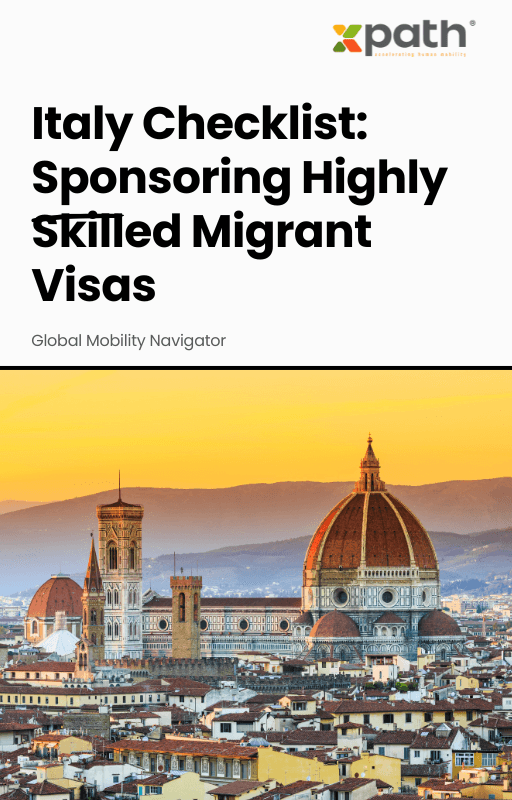Italy Checklist: Sponsoring Highly Skilled Migrant Visas
Grab a copy of a guide to international employee relocation
View E-bookGlobal talent moves faster than ever—and with that comes some unexpected hurdles. Ever wondered what happens to an employee’s retirement savings when they hop borders for work? Or why HR leaders often get headaches dealing with pension plans abroad? Let’s unpack the complex world of cross-border pension challenges and uncover the smart solutions businesses can use to empower their global teams.
In today’s hyperconnected world, international assignments aren’t reserved for top executives. In fact, Deloitte’s 2023 Global Mobility Trends report reveals that over 60% of organizations expect an increase in cross-border moves post-pandemic. Sounds exciting—until you dive into the complexity of supporting employees’ retirement plans across different countries. Diverse regulations, currency swings, and tax issues quickly turn pensions into a high-stakes puzzle. For organizations aiming to draw and keep the best talent globally, these hurdles aren’t just administrative—they shape success, satisfaction, and long-term loyalty.
Unlike domestic retirement arrangements, cross-border pensions face a tangled web of jurisdictional rules. For starters, every country has its own take on pension age, tax treatment, mandatory contributions, and portability. Just imagine an employee contributing to a 401(k) in the United States, then accepting an assignment in Germany where they face an entirely different system like the Gesetzliche Rentenversicherung (GRV). If the employee returns, changes jobs, or retires elsewhere, claiming those pension savings can be a logistical and legal minefield.
Language barriers and unfamiliar financial institutions only add to the stress. On top of that, some countries restrict the transfer of retirement savings, leaving workers with “stranded” or lost pots of money. It’s no shock that 35% of global mobility professionals cite international pensions as one of their most complex duties.
The challenge isn’t academic. Data from the Organization for Economic Cooperation and Development (OECD) shows international mobility is up nearly 20% since 2015. Meanwhile, the World Economic Forum estimates that globally up to $100 billion in pension assets may be ‘orphaned’ due to a lack of portability as professionals shift countries. That’s real money left on the table—a significant risk not only for employees but for organizations keen to remain competitive in lure of top-tier candidates.
Another emerging trend is rising demand for “total reward” programs that include transferable or globally recognized pension schemes. Flexible approaches like cash allowances, international pension plans (IPPs), and digital platforms for tracking cross-border benefits are starting to fill the gap—but only if organizations can navigate the compliance nuances.
Consider an IT professional seconded from the UK to Singapore. During her assignment, she contributes to Singapore’s Central Provident Fund (CPF), but her main retirement savings sit in a UK pension scheme. Four years later, she relocates again—this time to Canada. Without proper planning, she risks not only tax penalties but could struggle to eventually access her funds in retirement due to incompatible systems and cross-border transfer restrictions.
On the flip side, some multinationals have turned to international pension plans—solutions structured to accept contributions from multiple jurisdictions and pay benefits anywhere in the world. While these require upfront investment and careful governance, companies report higher satisfaction scores and fewer compliance headaches among their mobile staff.
Savvy employers are taking a multifaceted approach. First, collaboration with specialized global mobility partners (like xpath.global) streamlines compliance. These platforms offer real-time insights on location-specific pension mandates, helping you avoid costly mistakes and keep pace with the latest regulations. Second, proactive employee education goes a long way—arming international assignees with clear guides so they know what happens to their retirement savings before, during, and after their moves. Digital dashboards now allow HR teams and workers to track contributions, assess tax consequences, and plan disbursements all in one place.
Companies also gain peace of mind by establishing flexible policies—such as matching contributions in portable vehicles or leveraging financial products designed to “travel” as employees do. Some even provide professional pension advice as a standard part of relocation support, which can dramatically reduce stress and improve mobility outcomes.
Now more than ever, employees expect seamless experiences—no matter where their career adventures take them. Forward-thinking organizations that tackle cross-border pension challenges head-on are better positioned to attract, retain, and motivate their international talent. The right combination of tech, expert advice, and adaptable benefit structures delivers not just administrative efficiency but something even more valuable: employee trust.
With platforms like xpath.global, managing the cross-border pension maze is no longer a distant dream. Their comprehensive solutions harmonize policies, simplify compliance, and empower everyone—from HR directors to newly relocated employees—to focus on what truly matters: growth and success.
What is a cross-border pension?
A cross-border pension refers to a retirement savings plan affected by an individual working or living in more than one country. These can include local plans, international pension plans, or arrangements designed to be portable across jurisdictions.
Can I transfer my pension to another country?
Sometimes—but not always. Portability depends on the countries involved, respective pension rules, and international agreements (such as between EU countries). Check with both home and host country pension authorities before moving.
What’s the biggest risk with cross-border pensions?
Primarily, losing access or paying more taxes than necessary. Incompatible systems and lack of transfer agreements are common roadblocks.
How can companies simplify this for employees?
Employers can offer guidance, partner with global mobility experts, and consider international pension plans that allow smoother transitions and fewer regulatory issues.
Are digital platforms like xpath.global helpful?
Yes. They streamline compliance, improve transparency, and offer tools for tracking and managing cross-border pension obligations, making the whole process less stressful for everyone involved.
Ready to transform your mobility program? Explore xpath.global’s solutions.

Italy Checklist: Sponsoring Highly Skilled Migrant Visas
Grab a copy of a guide to international employee relocation
View E-book